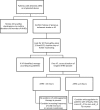Are atrial high rate episodes (AHREs) a precursor to atrial fibrillation?
- PMID: 31522249
- PMCID: PMC7098931
- DOI: 10.1007/s00392-019-01545-4
Are atrial high rate episodes (AHREs) a precursor to atrial fibrillation?
Abstract
Atrial high rate episodes (AHREs), also termed, subclinical atrial tachyarrhythmias or subclinical atrial fibrillation (AF) are an important cardiovascular condition. Advancement in implantable cardiac devices such as pacemakers or internal cardiac defibrillators has enabled the continuous assessment of atrial tachyarrhythmias in patients with an atrial lead. Patients with device-detected AHREs are at an elevated risk of stroke and may have unmet anticoagulation needs. While the benefits of oral anticoagulation for stroke prevention in patients with clinical AF are well recognised, it is not known whether the same risk-benefit ratio exists for anticoagulation therapy in patients with AHREs. The occurrence and significance of AHRE are increasingly acknowledged but these events are still not often acted upon in patients presenting with stroke and TIA. Additionally, patients with AHRE show a significant risk for major adverse cardiovascular events (MACE) including acute heart failure, myocardial infarction, cardiovascular hospitalisation, ventricular tachycardia/fibrillation, which is dependent on AHRE burden. In this review, we present an overview of this relatively new entity, its associated thromboembolic risk and its management implications.
Keywords: Anticoagulation; Atrial fibrillation; Atrial high rate episodes; Stroke; Thromboembolism.
Conflict of interest statement
GYHL has served as a consultant for Bayer/Janssen, BMS/Pfizer, Biotronik, Medtronic, Boehringer Ingelheim, Microlife and Daiichi-Sankyo; and a speaker for Bayer, BMS/Pfizer, Medtronic, Boehringer Ingelheim, Microlife, Roche and Daiichi-Sankyo. No personal fees received. GB has received small speaker’s fees from Medtronic, Boston, Boehringer, and Bayer, outside of the submitted work. AAK has no conflict of interest.
Figures
References
-
- Kirchhof P, et al. 2016 ESC Guidelines for the management of atrial fibrillation developed in collaboration with EACTS. Eur Heart J. 2016;37(38):2893–2962. - PubMed
-
- Kleemann T, et al. Prognostic relevance of new onset arrhythmia and ICD shocks in primary prophylactic ICD patients. Clin Res Cardiol. 2019 - PubMed
-
- Cheung JW, et al. Newly detected atrial fibrillation following dual chamber pacemaker implantation. J Cardiovasc Electrophysiol. 2006;17(12):1323–1328. - PubMed
-
- Healey JS, et al. Subclinical atrial fibrillation and the risk of stroke. N Engl J Med. 2012;366(2):120–129. - PubMed
-
- Ziegler PD, et al. Detection of previously undiagnosed atrial fibrillation in patients with stroke risk factors and usefulness of continuous monitoring in primary stroke prevention. Am J Cardiol. 2012;110(9):1309–1314. - PubMed
Publication types
MeSH terms
Substances
LinkOut - more resources
Full Text Sources
Medical


